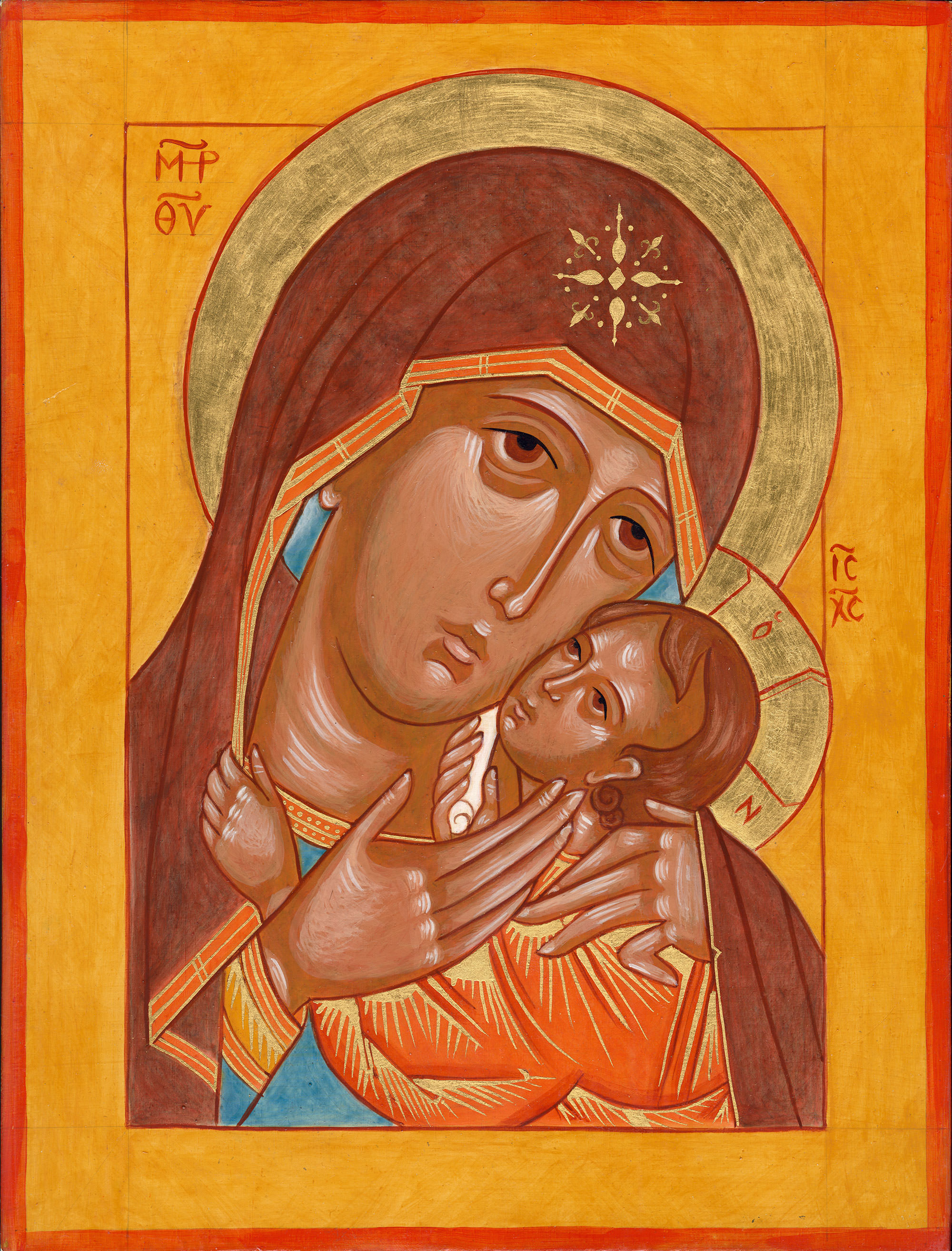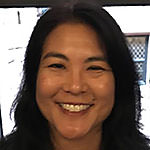
Prayer has always been a focus of my personal relationship with God and my discipleship. So much so, that as a ministry, I have spent the better part of my life helping people pray. In addition, as a created being, my own creativity has most directly been expressed in the visual arts. Being an iconographer brings the streams of prayer and painting together for me.
Beginnings
When I first met Charles Rohrbacher, a master iconographer, I was working full time for a college Christian fellowship as a prayer specialist. As I looked at his work and heard his stories about how prayer and intercession were seamlessly woven into the ministry God gave him as an iconographer, I felt a stirring of the Spirit. Given my background in art and prayer ministry, I wondered out loud to Charles and a mutual friend if this was a direction God would lead me someday. After my second son was born, I contacted Charles. Through a God-ordained series of events, Charles became my teacher and I started traveling to study with him in Juneau, Alaska.
My first commissioned icon was the Baptism of Christ. I worked with a colleague and biblical scholar on the theological and scriptural elements of the icon, and saw how the icon is the Word of God in paint and line in a deeper way. Scripture has always been my anchor and guide in prayer as I teach and mentor others. What seemed a direction became a personal calling.
Gaining Perspective on Icons
The word “icon” simply means “image”. A Christian icon is an image or scene including Jesus, Mary, or the saints that adheres to canonical, theological, and biblical orthodoxy. Therefore, the icon subject matter and symbolic elements are universal and necessarily limited. This adherence to theological and biblical truth is the reason that icons are commonly referred to as being “written”. Icons are the only official art of the undivided Church. The Christian Church was unified before the Great Schism in A.D. 1054 and the Protestant Reformation in the 16th century. As the Church matured, iconography flourished and was established in 843 as the officially sanctioned art of the Church.
A commonly recognized icon of Christ shows Him holding a book of the Gospels. The book of the Gospels can be opened or closed. If opened, traditional Words of Christ from the Gospels emphasize a particular characteristic of Christ meaningful to a particular congregation or person.
Other icons include major feast days, which are cornerstones of the Christian faith (e.g. the Annunciation, the Birth of Christ, the Baptism of Christ, the Crucifixion, the Resurrection). These are more complex icons that are packed with symbolism, biblical and historical references, and theological truth. Every element is there for a reason and is there to be “read” and understood. Knowing that these icons have been crafted carefully for accuracy, just as a monk would faithfully copy manuscripts, is great edification for the worshiper. The festal icons teach us what the church believes.
Every icon proclaims the presence of Christ. In the icons of the saints, Christ is made manifest in and through the saints that we recognize and honor.
“Christ in you, the hope of glory. It is he whom we proclaim, warning everyone and teaching everyone in all wisdom, so that we may present everyone mature in Christ” (Colossians 1:27b-28 NRS).
The icons of Mary, Jesus’s mother, are a bit different than icons of other saints based on her place in the Gospel story and church history. Some icons of Mary, like the one featured here, are with Jesus as a small child. The different positions and gestures of Mary and Jesus emphasize a different aspect of the Church, congregation, or individual’s relationship to Jesus. The icons are often referenced by that particular aspect, such as the “Tenderness” of the Mother of God (pictured here), or by a city from which the icon was derived and is usually associated with miraculous events. Mary’s Greek title is “Theotokos”, which is translated as “God-bearer”.
The icons of Mary have a unique place in the Church because of her special relationship to Christ as His earthly mother. Mary literally bore Christ in her body. And we are called as Christians and Christ’s Church to bear Christ into the world and our circumstances, with the same faithfulness that Mary exhibited in her response to the angel Gabriel:
“Behold, the bondslave of the Lord; may it be done to me according to your word” (Luke 1:38 NASB).
Presence
The icon represents the very real presence of God: Emmanuel, or “God with Us”. We believe that God is present at all times, and yet, sometimes we are more or less aware of His amazing presence. When I started my journey as an iconographer, I had already experienced the deep power and presence of Jesus in all types of prayer — devotional, corporate, healing prayer, and intercessory prayer. I had been through and directed countless workshops and trainings around this reality. What did it mean to have this as an articulated foundation in art? St. John of Damascus writes on the Divine Images (c. 730):
“ ... you saw no shape on that day.” Oh what wisdom on the part of the lawgiver! How can we make an image of the invisible One? How can we represent that which has no quantity, no height, no limits? What form are we going to assign to that which is without form? What then do we do with the mystery?
If you understood the incorporeal One became man for you, then it would be evident that you can make His human image.
Since the invisible One became visible by taking on flesh, you can fashion the image of Him whom you saw. Since He who has neither body, nor form nor quantity nor quality, who goes beyond all grandeur by the excellence of His nature, He, being of divine nature, took on the condition of a slave and reduced Himself to quantity and to quality by clothing Himself in human features. Therefore, paint on wood and present for contemplation Him who desired to become visible.
The icon proclaims the truth that the one true God made Himself visible in the human form of Jesus. Therefore, the human form of God can be represented in the image of Jesus. Its presence in our places of worship and prayer, whether public or private, is a proclamation of the truth and mystery of the incarnation. Because the icons have been carefully scrutinized as presenting Christian truth, as we pray with icons, God’s real presence is proclaimed and the foundation of our faith is strengthened and informed.
Even in its composition, the icon reflects the true and present nature of God and invites engagement. The icon uses inversed perspective, an Eastern viewpoint, which includes the viewer in its construction. With the advancement of science and the discovery of how human vision works physiologically, Western art started to reflect that science. This Western perspective of art made the viewer an “objective” observer, separating the viewer from the scene or subject matter by focusing on a vanishing point beyond the art plane.
In an icon, or inversed perspective, the vanishing point is in front of the icon where the viewer is, and so encompasses the viewer in the scene or in relationship to the subject. The image is flattened out and curved toward the viewer while still remaining believable. This perspective allows the viewer to see more of the image than modern Western art allows. This perspective reflects the truth that God is the one acting and initiating with us. He includes and invites us to be in relationship with Him and a part of what He is doing in us and in the world.
Notice in the “Tenderness” (see image), even in its intimate nature, we are not looking at an embrace between Jesus and Mary, but we are included in that embrace — that very real dynamic of mother and child, God and creature. Just as God initiates with us, in the icon, we are invited not as observers, but participants in a relationship with Christ Himself, through His Word and through the saints.
Perseverance and Prayer
I painted the Tenderness icon featured here for my mother who was in her last year of life. She was at the end of a long struggle with Alzheimer’s disease and was approaching her 80th birthday. I wanted to paint an icon for her, and I believed it would help me engage in prayer for her and the very challenging situation.
I realized in prayer that God’s invitation to me was the path of love and tenderness for my mother: His love for my mother and for me, and perhaps somewhere in there, her love for me and for God. Praying for my mother as I painted the icon helped me engage with the reality of the situation with God, pray for the real needs, and be present in what God was doing in me. I learned in a deep way what it meant to be present with my mother when her fierce and inspiring personality was gone. How was she still a living reflection of the image of God? The process changed the way I looked at people in everyday life: true images of God to be honored, reverenced, and loved.
Perseverance in prayer is inherent in the painting of an icon. I imagine that the process and obstacles that arise are as personal as the iconographer. I allow the Lord to help me pray more deeply and listen more carefully to God for the community or individuals I am painting the icon for. I ask God to show me how obstacles or difficulties (technical or otherwise) that I run into in the process can be an opportunity for personal growth, and possibly, insight into a dynamic presence in the community or person’s life. Likewise, any grace or mercy that I am experiencing can be a word of encouragement or blessing.
The icon I started to paint for my mother for her 80th birthday was a different icon of Mary and Jesus: the Hodegetria (“Guiding Lady”), a formal icon of Mary holding Jesus and gesturing toward Him, presenting Him to the world as she presented Christ to our family. My mother was the Christian parent in our family, and she had a fierce and inspiring personality. However, I struggled technically with the icon. It was through perseverance in prayer and seeking God’s wisdom that I recognized God’s invitation to a path of deeper love and tenderness for my mother, a deeper experience of His tender love for my mother and for me, and a still, present love my mother had for me and for God. I finished the Hodegetria, but the icon that I gave to my mother was of the Tenderness icon.
An Act of Faithfulness
Finally, the process of finishing an icon is an act of worship I offer up as the best, most faithful work I can do to a God who loves His people and requires faithfulness, not perfection. I pray that the invisible God — who revealed Himself in the life, death, and resurrection of His Son, and through the power of the Holy Spirit — would indeed be made visible in the icons I paint and in me.

Sharon Henthorn-Iwane is an iconographer residing in Berkeley, CA. Sharon spent ten years on staff with InterVarsity Christian Fellowship. She continues ministering in church leadership, prayer and spiritual direction in both Catholic and Protestant churches. Her website is prayericons.com.